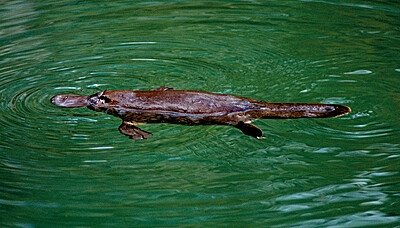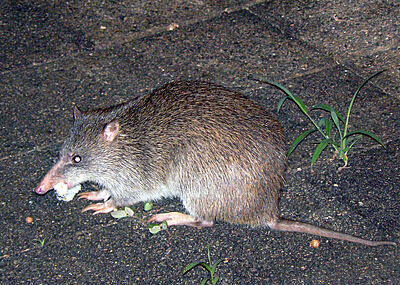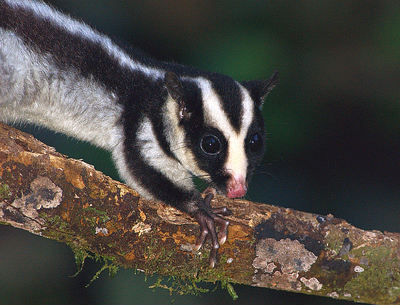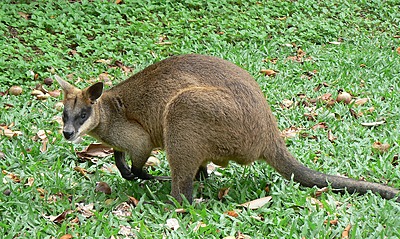MAMMALS
Whilst it is generally easier to see a range of mammals in the higher or dryer regions of Tropical North Queensland, the tropical lowlands of the Daintree have many glorious specimens of some of Australia’s unique fauna.
MONOTREMES
Monotremes (egg-laying mammals) only occur in Australia and New Guinea. Daintree is privileged to have both of Australia’s monotremes, the Platypus and the Echidna:-
PLATYPUS

The amphibious Platypus is shy and is best seen when it is more active around dawn and dusk.
It has short limbs, webbed feet and a leathery snout (mistakenly called the ‘Duck-billed Platypus’) and is widespread along the eastern coast of Australia, but it is shy and sometimes difficult to see.
It inhabits coastal streams and farm dams in the Daintree and feeds on invertebrates. It is generally much smaller in Tropical North Queensland than you would expect to see in the southern states.
ECHIDNA
A mainly nocturnal mammal, the Echidna or “Spiny Anteater” has a wide distribution, including the tropical rainforest. Cat-sized, the Echidna has strong, sharp spines over the body, and strong, short legs with long claws for digging, and a long sticky tongue for feeding. It feeds on ants, termites and beetle larvae from the soil.
MARSUPIALS
Marsupials are well developed and common in Australia and include the Koala, Kangaroos and Wallabies, Possums, Bandicoots, Bats and Rodents. They give birth to live, underdeveloped young which then continue to develop in the pouch of the mother, suckling at a teat protected by the pouch:-
BANDICOOTS

Northern Brown Bandicoot and Long-nosed Bandicoot can be seen in the Daintree. They are nocturnal and feed on invertebrates, fruits and tubers dug up using their long snout.
The Northern Brown Bandicoot is the size of a rabbit, has short ears and a longish snout, and with coarse hair. Commonly seen in urban areas and crossing the road at night, they have poor eyesight. Prolific breeders, the females are able to produce up to four young every two months.
The Long-nosed Bandicoot is greyer and with a longer snout and longer, narrow and pinkish ears. It is less frequently seen than the Northern Brown Bandicoot.
POSSUMS

Active at night, possums are arboreal and have adapted to grip onto branches with their feet and/or tail. More species of possum inhabit the upland forests of Tropical North Queensland, but the lowland Daintree rainforest has the following:-
Common Striped Possum - a distinctive black and white possum with coarse fur, the Striped Possum is not common, but easily recognized as it noisily feeds and moves through the canopy. It has an extended 4th finger to extract grubs from the wood.
Daintree River Possum - a little-known Ringtail Possum with a very small distribution range in the higher altitudes of the Daintree (Thornton’s Peak).
WALLABIES AND KANGAROOS
 Musky Rat Kangaroo - the most primitive of the kangaroos, it is also the smallest and the only one with five toes. The Musky Rat Kangaroo is restricted to the floor of the rainforest in north east Australia. A similar size to a bandicoot, but with an upright posture and with dark reddish-brown fur. It feeds during the day on the rainforest floor on fruit, fungi and insects.
Musky Rat Kangaroo - the most primitive of the kangaroos, it is also the smallest and the only one with five toes. The Musky Rat Kangaroo is restricted to the floor of the rainforest in north east Australia. A similar size to a bandicoot, but with an upright posture and with dark reddish-brown fur. It feeds during the day on the rainforest floor on fruit, fungi and insects.
Bennett’s Tree Kangaroo - one of only two tree kangaroos in Australia, dwelling in the canopy of the rainforest, eating leaves of the trees and vines. Grey-brown in colour, with black feet, a grey head and a rufous crown, neck and shoulders. The Bennett’s Tree Kangaroo has a very small range along the coast from the Daintree River to south of Cooktown. They are uncommon, and rarely seen but your best chance would be early morning or late afternoon on the Jindalba Boardwalk or Jindalba Circuit Track.
Swamp Wallaby - a medium-sized stocky wallaby, the Swamp Wallaby has thick dark fur with a black muzzle and a white stripe along the cheek. It is mainly nocturnal, is solitary and shy, and browses on grasses, ferns and shrubs. Common along the east coast of Australia, including the Daintree.
BATS
Spectacled Flying-Fox - a large flying fox being black and with a large patch of straw-coloured fur on the mantle and around the eyes. It is only found in Australia’s tropical rainforest and while common locally, is a vulnerable species. The main threat is clearing of the rainforest. They are nocturnal, living in large groups in camps, roosting in the top of trees during the day, and flying out at night to feed on pollen and fruits. They play a vital role is pollination and seed dispersal. They have good vision and travel up to 50km each night.
Smaller bats include the Eastern Blossom Bat and Eastern Tube-nosed Bat, both of which feed on nectar, pollen and soft fruit.
RODENTS
Water Rat - a large, sleek rat with colours ranging from black to golden-brown. A nocturnal rat, foraging in the water or adjacent vegetation for invertebrates, frogs, fish and small birds. It is sometimes mistaken for a Platypus when swimming.
Giant White-tailed Rat: A large grey rat with course hair and the final third of its’ tail white. It is solitary, mainly nocturnal and is a strong climber. It is very efficient at gnawing and eats fruit, seeds, fungi, insects, crabs, birds eggs (and electrical wiring).
Melomys - small mouse-like mammals, with short dense grey or brown hair and whitish underneath. The long slender tail has scales in a mosaic pattern. Nocturnal and agile climbers, they eat roots, leaves, shoots and fruits.
The Daintree Marketing Co-Operative acknowledges the custodianship of the Daintree Rainforest and Great Barrier Reef by the local Kuku Yalanji people whose rich cultures, heritage values, enduring connections and shared efforts protect our natural assets for future generations, and we pay our respect to elders past, present and emerging.
The Destination Daintree website is a project of the Daintree Marketing Co-Operative Ltd. Site credits...
©2014 The copyright for all the text and images on this site remains with the original authors and creators. Daintree Marketing Cooperative has been granted permission to reproduce said text and images.

